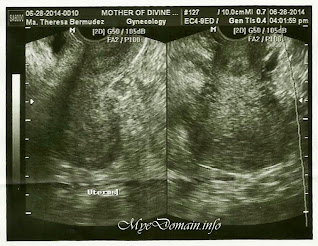In order to fully understand the term Adenomyosis, let's take my case for example. Eight years ago, I was diagnosed with this condition. This is the result of my ultrasound dated June 28, 2014. Since it was an illness I had, long time before my menopause finally hit me, it's better to share the experience with women like me, married or single.

MYE DOMAIN ENTRY
July 6, 2014
Since my former OB is now in Canada, my records are being turned over to Dra. Joanne V. Legaspi. She's also affiliated with The Medical City and Ardi Health Care Center. Dra. Legaspi advised me to undergo TVS (Transvaginal Ultrasound) for an accurate diagnosis of my condition.
I took the ultrasound immediately. Thanks to my hubby who's always willing to accompany me in times like this.
DIAGNOSIS:
- NORMAL SIZED RETROVERTED UTERUS MILD ADENOMYOSIS
- THIN ENDOMETRIUM
- NORMAL RIGHT OVARY
- CYSTIC FOLLICLE, LEFT
- NO FLUID IN THE CUL DE SAC
I've been diagnosed with mild Adenomyosis. I had it long before my second childbirth but, I didn't feel any discomfort until I had this symptom of prolonged menstrual flow.
So, what is Adenomyosis?
It's is a condition that involves the movement (encroachment) of endometrial tissues, which normally line the uterus, into the muscles of the uterus.
Adeno - the Greek term for gland
Myo - means muscle
Osis - means a condition
While the exact cause of adenomyosis is unknown, there are factors that put women at greater risk for the condition. These include:
- being in your 40s or 50s (before menopause)
- having children
- having had uterine surgery, such as for a cesarean section or to remove fibroids (Mayo)
What are the symptoms?
Symptoms of this condition can be mild to severe. Some women may not experience any signs at all. The most common symptoms include:- prolonged menstrual cramps
- spotting between periods
- heavy menstrual bleeding
- longer menstrual cycles than normal
- blood clots during menstrual bleeding
- pain during sex
- tender abdominal area
Dra. Legaspi prescribed Tranexamic and Mefenamic Acid (both 500mg). I took 2 capsules of the former and 1 of the latter three times a day for three days and fortunately, the bleeding stopped.
NOTES: Medical reference - Healthline and Wikipedia
This comment has been removed by a blog administrator.
ReplyDeleteAdenomyosis is a medical condition that affects the uterus, specifically the endometrium (the inner lining of the uterus). In adenomyosis, the endometrial tissue grows into the muscular wall of the uterus, which is called the myometrium. This abnormal growth can cause the uterus to become enlarged, swollen, and tender.
ReplyDeleteThe exact cause of adenomyosis is not known, but it is believed to be related to hormonal imbalances, specifically estrogen. Adenomyosis is most commonly diagnosed in women who have had children and usually occurs in women between the ages of 40 and 50. However, it can occur in women of any age.
The symptoms of adenomyosis can vary from mild to severe and may include:
Heavy or prolonged menstrual bleeding
Severe menstrual cramps or pelvic pain
Painful intercourse
Enlargement of the uterus
Blood clots during menstruation
Pressure or a feeling of heaviness in the pelvic area
The diagnosis of adenomyosis typically involves a combination of a thorough medical history, physical examination, and imaging tests. Ultrasound and magnetic resonance imaging (MRI) are commonly used to visualize the uterus and assess the extent of adenomyosis.
Treatment options for adenomyosis depend on the severity of symptoms, the desire for future fertility, and individual circumstances. Conservative treatments may include pain medication, hormonal therapies (such as birth control pills or intrauterine devices containing progestin), or nonsteroidal anti-inflammatory drugs (NSAIDs) to manage pain and reduce inflammation.
In more severe cases, when conservative treatments are ineffective, or if the woman has completed childbearing, surgical interventions may be considered. These can include procedures such as endometrial ablation (removal of the uterine lining), uterine artery embolization (blocking the blood vessels that supply the uterus), or in some cases, a hysterectomy (removal of the uterus).